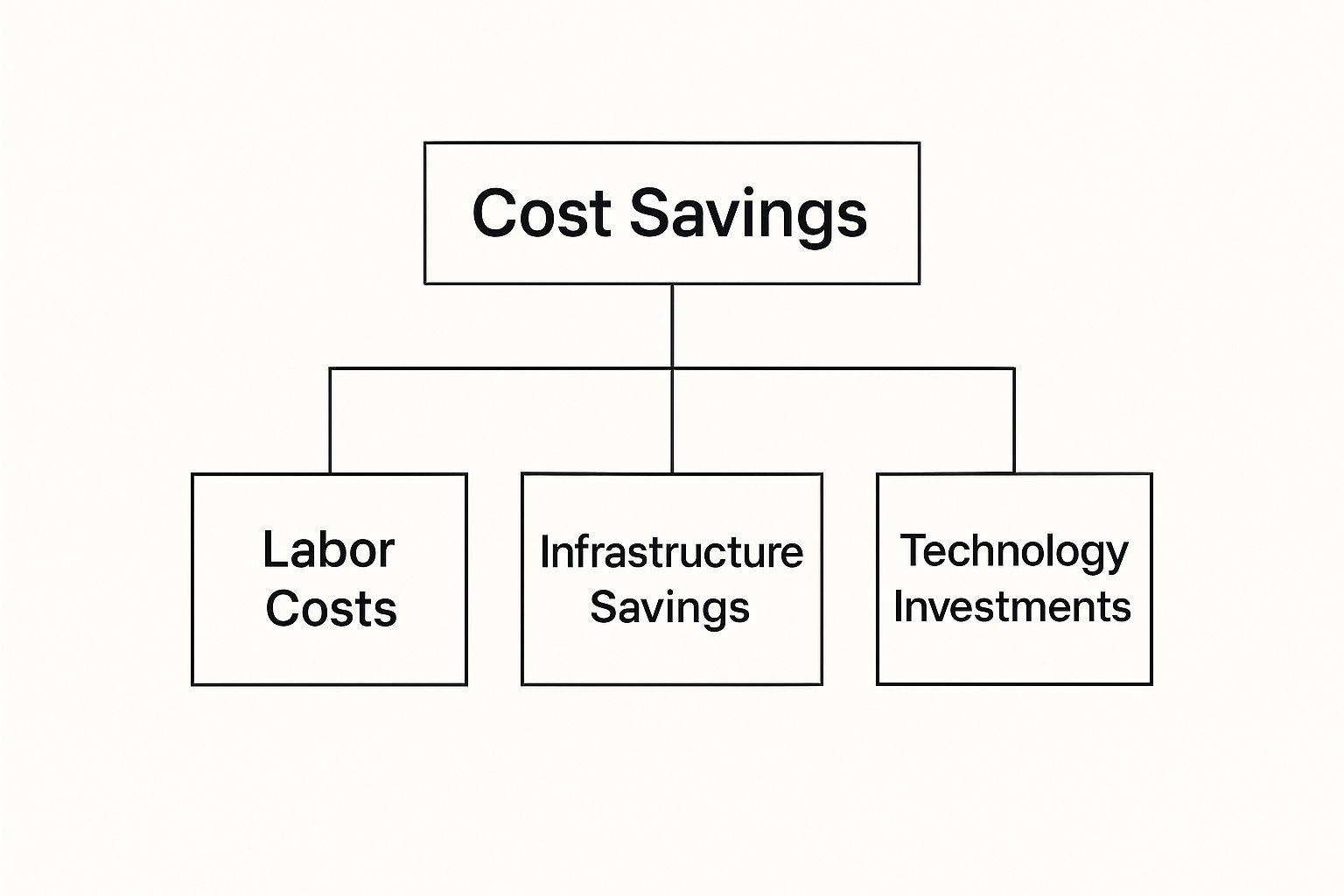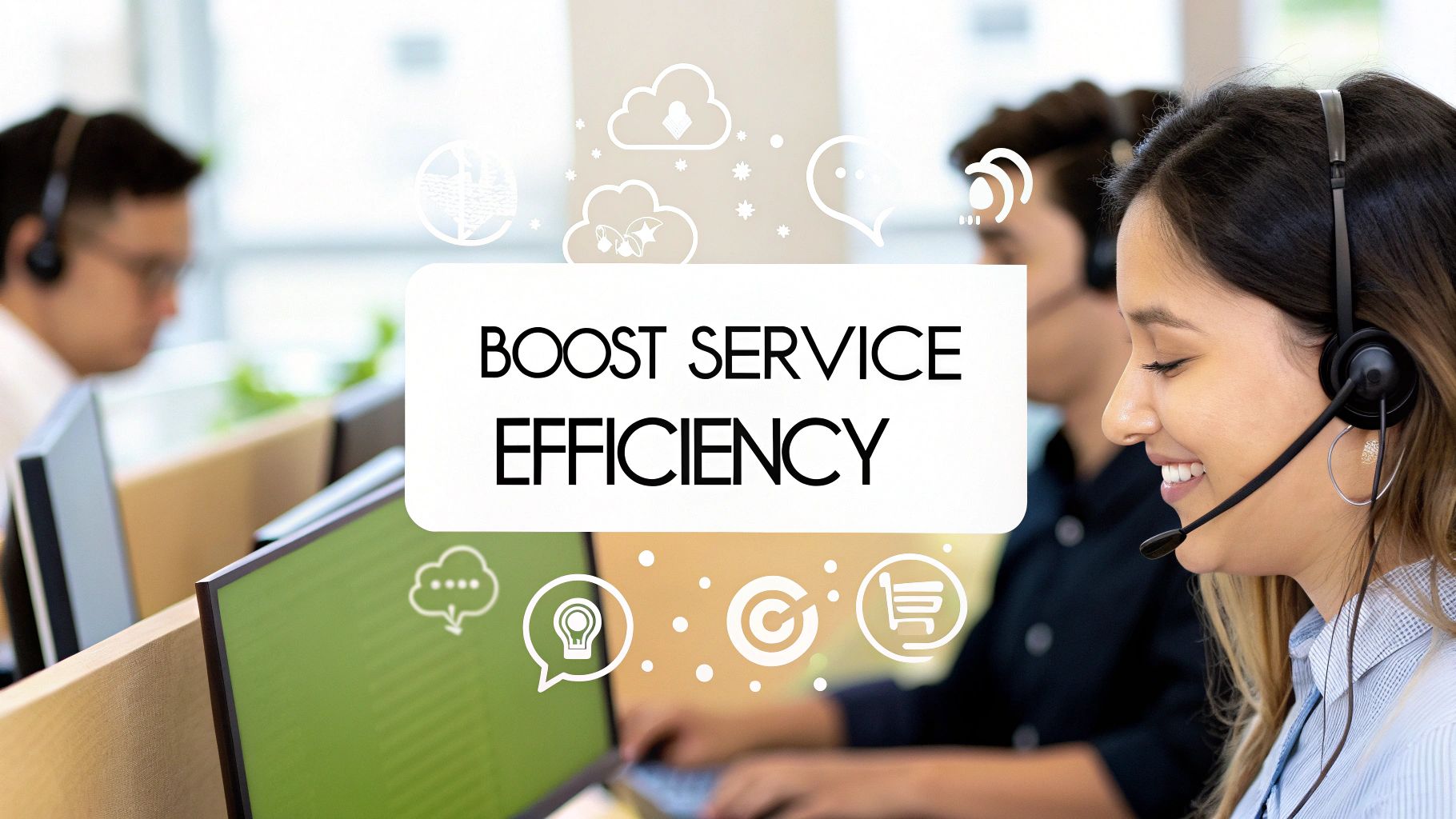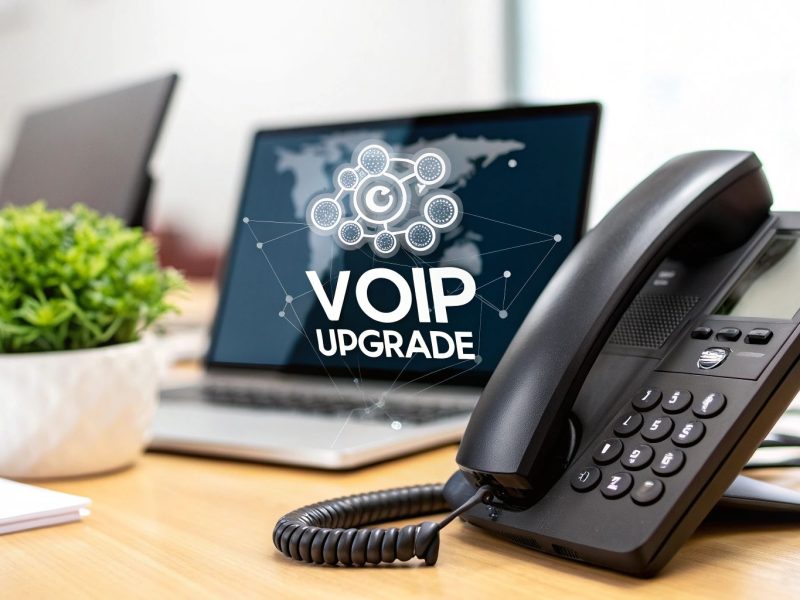Understanding Contact Center Outsourcing Beyond The Basics
Think of contact center outsourcing like hiring a caterer for a big event. You wouldn't expect your in-house cafeteria staff to handle a complex banquet, right? Similarly, top-notch customer service often requires specialized skills and resources that a dedicated external team can best provide. Outsourcing isn't just about saving money; it's a strategic way to boost your overall customer experience.

This screenshot from Wikipedia shows a typical contact center setup, highlighting the complex infrastructure involved.
The image shows the investment needed for in-house contact centers: hardware, software, and trained staff. This is why many businesses choose to outsource – they can tap into existing infrastructure and expertise. Imagine a growing e-commerce company in the UAE. Instead of building a contact center from scratch, they could partner with a provider like Cloud Move and use their established platform and agents. This lets the company focus on core activities like marketing and product development while scaling customer service quickly and efficiently.
Rethinking Control in the Outsourcing Model
Many worry about losing control when outsourcing. But modern outsourcing is more like a partnership. It's like adding a specialized team to your existing capabilities. For example, a provider's advanced analytics can give you valuable insights into customer behavior. You can then use this data to improve your strategies and gain better control over the customer journey. Service Level Agreements (SLAs) also help maintain service quality and ensure the provider meets performance targets. You keep control over key performance indicators while benefiting from the provider's know-how.
Shifting from Cost-Cutting to Strategic Partnership
While cost savings are important, successful outsourcing is about a strategic partnership. A strong vendor relationship leads to innovation and continuous improvement. Imagine your provider introduces AI-powered chatbots. These bots handle routine questions, freeing up your agents for more complex issues. This improves customer experience and reduces costs. A strategic partner also actively supports your business goals, adapting to your needs and offering proactive solutions. This collaborative approach is what sets a true partnership apart from simply hiring a vendor. When done right, contact center outsourcing becomes an extension of your business, driving growth and building customer loyalty. This leads us to explore how customer service models are changing, which we'll cover next.
The Evolution From Voice Calls To Omnichannel Excellence
Remember the old days of customer service? Rotary phones, a single operator plugging and unplugging cords to connect calls. It’s a far cry from how customers reach out today – smartphones, website chat, social media, even video calls. This shift reflects a huge change in customer service, and contact center outsourcing has adapted every step of the way. Early outsourcing was all about handling those basic inbound and outbound calls, often seen as a simple way to manage high call volumes. But as customer expectations changed, so did the demands placed on contact centers.
This transformation led to the development of omnichannel contact centers. Think of it as a central hub connecting every way a customer might want to interact with your business. These platforms bring together various communication channels – voice, email, chat, social media, and even newer channels like video support. This allows businesses to meet customers wherever they prefer, offering a smooth experience regardless of how they choose to connect.
Imagine a customer starting by browsing FAQs on your website, then hopping onto a live chat for quick clarification, and finally following up with an email for detailed documentation. An omnichannel approach ensures they have a consistent and personalized experience at every touchpoint. A deeper dive into omnichannel strategies can be found here: The Impact of Using Omnichannels in Contemporary Call Centres.
The Rise of Cloud-Based Contact Centers
A major driver of this change has been the rise of Contact Center as a Service (CCaaS). It’s like renting a fully equipped kitchen instead of building one from scratch – you get everything you need to start cooking right away. CCaaS provides a cloud-based platform packed with all the tools and technology for managing customer interactions, without the huge upfront investment in hardware and software. This makes it an attractive and scalable option for businesses of all sizes.
This ease of access is particularly important in the AE region, where cloud adoption is accelerating. The Middle East's CCaaS market is a prime example. In 2024, it was valued at USD 420.9 million, projected to reach USD 479.3 million by 2025. By 2032, it's expected to almost double to about USD 1.12 billion. This growth, with a CAGR of 12.9%, shows the increasing shift toward cloud-based, digital-first customer engagement. Discover more insights.
Understanding this evolution of customer interaction is crucial for contact center outsourcing success. Learn more about how companies are using omnichannel customer service: omnichannel customer service. This move to the cloud also brings greater flexibility and scalability. Businesses can quickly adjust their capacity to match demand, adding or removing agents as needed – vital in today’s fast-paced market.
The Impact on Cost Savings

The infographic above shows how contact center outsourcing can lead to cost savings in key areas like labor, infrastructure, and technology investments.
The infographic highlights the financial advantages of outsourcing. From lower labor costs by accessing a global talent pool to significant infrastructure savings with cloud-based solutions, businesses can optimize their spending and use resources more effectively. This allows for a more efficient allocation of resources towards improving technology and the customer experience.
To understand the different ways you can structure your contact center outsourcing, let’s look at a comparison of the most common delivery models. The table below outlines the key differences between on-premise, hybrid, and cloud-based solutions.
Contact Center Delivery Models Comparison
| Delivery Model | Initial Investment | Scalability | Technology Features | Best For |
|---|---|---|---|---|
| On-Premise | High | Limited | Dependent on owned hardware/software | Large enterprises with complex needs and existing infrastructure |
| Hybrid | Moderate | Moderate | Mix of on-premise and cloud features | Businesses transitioning to the cloud or needing a blend of control and flexibility |
| Cloud (CCaaS) | Low | High | Latest features, automatic updates | Businesses of all sizes seeking flexibility, scalability, and cost-effectiveness |
This table highlights the trade-offs between control, cost, and scalability. While on-premise solutions offer greater control, they come with a high initial investment and limited scalability. CCaaS, on the other hand, offers the greatest flexibility and scalability at the lowest initial cost. Hybrid models provide a middle ground, allowing businesses to tailor their approach based on their specific needs.
Why Smart Companies Choose Outsourcing As A Growth Strategy

Imagine having a dedicated team of experts at the ready, handling all your customer interactions while you focus on steering your business towards its goals. That's the power of a well-executed contact center outsourcing strategy.
Think of it like building a high-performance race car. You could try to manufacture every single part yourself, from the engine to the tires. Or, you could collaborate with specialized manufacturers, bringing their expertise to bear on each component. This allows you to focus on the car's overall design and performance.
Contact center outsourcing works on a similar principle. It's about bringing in specialized expertise so you can concentrate on what you do best: growing your business.
Access to Specialized Expertise and Technology
Outsourcing opens the door to a pool of highly trained agents seasoned in navigating the complexities of customer interactions. These teams often have access to cutting-edge technology and tools, providing a level of service that would be a significant investment to build in-house.
Think about the advantages of advanced analytics, AI-powered chatbots, and tight CRM integrations. These enhance customer engagement and streamline operations. As contact centers move towards omnichannel excellence, tools like chatbots become increasingly important. Want to learn more about integrating chatbots? Check out this guide on how to add chatbot to website.
This frees up your internal teams to focus on the big picture: strategic initiatives, product development, and other core functions that drive your business forward.
Operational Flexibility and Scalability
The business world, especially in the AE region, is a fast-paced and competitive arena. Outsourcing provides the agility to scale your contact center operations up or down rapidly, responding to the ebb and flow of market demands.
This adaptability is essential, particularly for businesses experiencing seasonal peaks, periods of rapid growth, or unexpected market shifts. Imagine launching a new product that generates a surge in customer inquiries. An outsourced contact center can quickly adjust staffing to meet the increased demand, ensuring smooth customer service and maximizing sales potential. Trying to achieve this level of scalability internally can be both complex and costly.
Cost Optimization and Efficiency
Cost efficiency is a major factor driving contact center outsourcing, especially in emerging markets like the Middle East and Africa. Studies reveal that businesses can save 40-60% on operational costs by adopting this strategy.
What's more, top-performing outsourced contact centers see a 7.5% year-over-year improvement in both customer satisfaction and operational metrics. Want to delve deeper into these figures? Discover more insights.
These cost savings can then be reinvested into growth initiatives, fueling marketing campaigns, product development, and expansion into new markets. While cost reduction is a significant benefit, the strategic advantages of outsourcing go beyond the bottom line.
By focusing on core business activities and leveraging external expertise, companies can elevate customer satisfaction, accelerate growth, and stay ahead of the competition in today’s dynamic marketplace. This strategic approach to contact center outsourcing is a key ingredient for businesses looking to scale and thrive in the AE region and beyond.
Navigating The Real Cost Landscape Beyond Sticker Prices
Let's talk about the real cost of contact center outsourcing. It's a bit like buying a car. You see the sticker price, but then there's insurance, gas, maintenance…it all adds up. Similarly, with outsourcing, the initial quote is just the starting point. There's a whole ecosystem of costs to understand before you make a decision. This section will break down those components, giving you a clearer picture of the financial commitment.
Decoding Different Pricing Models
Contact center outsourcing comes with a variety of pricing structures. Think of it as choosing a mobile phone plan. You have different options depending on your usage. A common model is the per-agent monthly fee. This is like a flat subscription rate – a fixed cost per agent every month, covering their salary, training, and platform access.
Another option is transaction-based pricing, where you pay per interaction – calls, emails, chats. This is like paying as you go and can be good for businesses with call volumes that fluctuate like the tide.
Then you have setup costs, kind of like an activation fee for your phone. This covers things like integrating your systems and initial training. And finally, some providers offer performance incentives, like bonuses for hitting targets or penalties for falling short. Understanding these models is key to comparing apples to apples and picking the right plan for your business.
Unveiling Hidden Expenses and Long-Term Value
Remember those extra car costs we talked about? Well, outsourcing has some hidden costs too. These might be integration fees with your current CRM, software licenses, or ongoing maintenance. It's crucial to have open and honest conversations with potential providers to uncover these potential surprises.
Outsourcing can be a real game-changer for growth, especially when you're scaling a SaaS business. It allows you to focus on your core product and leave the customer service to the experts. Here's an article on broader growth strategies for SaaS businesses: SaaS Growth Strategies.
However, fixating only on upfront costs can be a mistake. Think long-term value. A reliable provider can boost customer satisfaction, increase sales, and ultimately strengthen your bottom line. These long-term gains often outweigh the initial investment.
Budgeting and Cost Optimization Strategies
Like any smart investment, effective budgeting is crucial. Start by defining your needs and anticipated call volumes. This is like figuring out how many minutes you need on your phone plan. Then, get quotes from multiple providers, comparing pricing models and what's included. It pays to shop around!
Also, remember that pricing can change based on service levels and location. A provider in one region may have different rates than one on the other side of the world. Once you've picked a provider, regularly review their performance and look for ways to optimize costs. This might mean renegotiating your contract, streamlining processes, or using technology to automate tasks. By proactively managing costs, you get the most bang for your buck.
To help you understand the typical costs involved, let’s look at a breakdown:
Contact Center Outsourcing Cost Breakdown
Detailed analysis of typical cost components and pricing models in contact center outsourcing
| Cost Component | Percentage of Total Cost | Typical Range | Factors Affecting Price |
|---|---|---|---|
| Agent Fees | 50-70% | $1,500 – $3,000 per agent/month | Location, experience, language skills |
| Platform Fees | 10-20% | $50 – $200 per agent/month | Features, integrations, usage |
| Setup Fees | 5-10% | $5,000 – $20,000 | Project complexity, customizations |
| Management Fees | 5-10% | Variable | Provider's pricing model |
| Other Fees (Training, Quality Assurance) | 5-10% | Variable | Specific services included |
As you can see, agent fees usually make up the lion’s share of the total cost, followed by platform fees. However, setup fees can be a significant initial investment. Several factors, including the provider's location and the complexity of your setup, can influence these costs.
By thoroughly understanding the cost landscape, you can make informed decisions and build a successful outsourcing partnership that aligns with your goals and budget. This sets the stage for choosing the right outsourcing partner – a topic we'll explore in the next section.
Finding Your Perfect Outsourcing Partner Through Smart Selection

Choosing the right contact center outsourcing partner is a big decision. Think of it like choosing a contractor to build your dream house. You wouldn't simply pick the lowest bid without checking their references and past projects, would you? This section guides you through the selection process, helping you find a partner that truly aligns with your business goals.
Beyond the Glossy Brochures: Asking the Right Questions
Don't be fooled by fancy presentations and marketing speak. The real value lies in asking insightful questions that uncover a provider's true capabilities. For instance, ask about their experience in your specific industry. A provider specializing in retail might not be the best fit for a financial services company.
Ask about their agent training programs and quality assurance processes. A well-trained team is the cornerstone of excellent customer service. Also, understand their approach to handling tricky customer interactions. Do they have strategies for de-escalation and conflict resolution?
Dig into their technology. Do they offer omnichannel solutions like Five9? Can they integrate with your existing CRM like Salesforce? These are key factors for smooth customer interactions and efficient data management.
Assessing Technical Prowess and Team Expertise
Evaluating a provider's technical infrastructure is like checking the foundation of a house. A weak foundation leads to problems later on. Look for providers with robust and reliable technology. Can they handle high call volumes without system failures? Do they have backup systems for emergencies? These are vital questions to ask.
Team expertise is equally critical. Ask about their agents' experience and qualifications. Do they provide ongoing training and development programs? A provider invested in its team is more likely to deliver top-notch service. This is especially true if you operate in a multilingual environment, where supporting different languages is essential.
Decoding Service Level Agreements (SLAs) and Security Measures
Service Level Agreements (SLAs) are the blueprints of your outsourcing partnership. They outline performance expectations and guarantees. Don't just glance at them; understand the metrics being tracked, the penalties for not meeting those metrics, and the reporting procedures. A solid SLA should protect your interests and ensure the provider delivers on its promises.
Security is paramount, especially when dealing with sensitive customer data. Ask about the provider's security protocols and certifications. Are they compliant with relevant data privacy regulations like GDPR? Do they have measures in place to prevent data breaches? These are non-negotiable aspects of a secure and reliable partnership.
Due Diligence and Negotiation Strategies
Before signing a contract, perform thorough due diligence. It's like getting a home inspection – you want to identify any hidden problems. Check the provider's references and talk to their current clients. Ask about their experiences, good and bad. This provides invaluable insights into the provider's performance and work style.
Negotiation is a two-way street. Strive for a mutually beneficial partnership. Be clear about your needs and be prepared to compromise on some points, but never compromise on core requirements like service quality and security. A well-negotiated contract sets the stage for a successful and long-term outsourcing relationship. By taking these steps, you'll be well-prepared to find the ideal contact center outsourcing partner for your business – one that helps you improve customer service, fuel growth, and achieve your strategic objectives. This brings us to the next critical step: effectively implementing your chosen solution.
Implementation Excellence: From Handshake To Seamless Operations
Implementing a contact center outsourcing solution isn't like flipping a switch. It's more like orchestrating a complex symphony, where every instrument needs to be in tune and the conductor (that's you!) guides the performance to a standing ovation. It takes careful planning and execution to make sure the transition is smooth and the results hit all the right notes.
Planning and Knowledge Transfer: Laying the Foundation
The initial phase is all about laying the groundwork. Imagine building a house – a solid foundation is essential. This stage involves defining clear goals, identifying your key performance indicators (KPIs), and setting a realistic timeline. It’s crucial to transfer knowledge effectively, like passing on a cherished family recipe. Document your processes, training materials, and customer interaction guidelines to ensure your outsourced team understands your unique needs and preferences.
Go-Live Coordination and Ongoing Optimization: The Grand Opening
The go-live phase is the grand opening of your new, improved contact center. Everything needs to be in place and working seamlessly. This requires coordinating systems integration, thoroughly testing processes, and training your outsourced team on your specific requirements. Once live, ongoing monitoring and optimization are essential. Think of it like tending a garden – you need to nurture it consistently to ensure it flourishes. Regularly review performance against your KPIs and adjust as needed to achieve optimal results.
Managing Organizational Change and Ensuring Customer Satisfaction: Keeping Everyone Happy
Introducing a new system always brings change, and change can sometimes feel unsettling. Clear and consistent communication with your internal teams is vital. Address any concerns and provide adequate training to smooth the transition. It’s like reassuring your restaurant staff during a renovation – keeping everyone informed minimizes disruption and fosters a positive atmosphere.
Customer satisfaction is paramount throughout this process. Ensure a seamless handover, maintain service levels, and address any customer issues promptly. Think of your customers as diners in your restaurant – you want their experience to be exceptional, regardless of any behind-the-scenes changes.
Governance and Accountability: Maintaining Quality and Control
Establishing clear governance and accountability is crucial for long-term success. Regular meetings, performance reviews, and open communication channels keep everyone on the same page and help maintain a strong, collaborative partnership. This is similar to regular check-ins with your restaurant manager – they ensure everything runs smoothly and address any issues proactively.
By following these implementation best practices, you can transform your contact center outsourcing initiative from a simple handshake into a seamless, value-driven operation. This structured approach minimizes potential problems, speeds up the realization of benefits, and creates a foundation for sustainable operational excellence. Think of it as a well-oiled machine, consistently adapting and improving to deliver outstanding customer experiences and drive business growth.
Understanding The Market Momentum Behind This Growth Wave
The contact center outsourcing industry is experiencing a surge in popularity, particularly in emerging markets like the AE region. Think of it like this: businesses are realizing that top-notch customer service is their secret weapon in the global arena, and outsourcing is becoming the go-to strategy to achieve it. Just like a company might bring in logistics experts to handle complicated shipping, sometimes it's best to let the pros handle customer interactions. So, what's fueling this growth spurt?
Digital Transformation and Evolving Customer Expectations
The shift to digital is a major catalyst. As businesses move online, customer interactions are becoming more intricate. Customers now expect instant, personalized service across various channels—phone, email, chat, social media—and they want it available around the clock. Meeting these demands requires cutting-edge technology and highly skilled agents, precisely what outsourcing providers excel at. Imagine trying to cook a gourmet meal with basic kitchen tools; you need specialized equipment to truly shine, and that's what outsourcing offers.
Competitive Pressures and the Need for Agility
In today's fast-paced market, businesses need to be nimble and responsive. Contact center outsourcing provides that flexibility. Companies can scale their operations up or down as needed, much like a restaurant adjusts its staff based on how busy it is. This adaptability allows them to handle peak customer inquiries efficiently without excess staffing during quieter periods, ultimately optimizing resources and costs.
Regional Economic Factors and Workforce Development
The AE region's economic growth and emphasis on workforce development also contribute to the trend. Governments are investing in training programs to cultivate a skilled customer service workforce, making the region an attractive hub for outsourcing providers. This creates a mutually beneficial scenario: businesses gain access to a qualified talent pool while simultaneously supporting local economies.
Over the last decade, the Middle East & Africa (MEA) contact center outsourcing sector has seen impressive growth. In 2024, the region's market reached USD 2.1 billion. Projections indicate a CAGR of 10.4% from 2025 to 2030. Discover more insights. This rapid expansion highlights the growing importance of customer service excellence in the region.
Early Adopters and Market Maturation
Businesses that embraced contact center outsourcing early on are already reaping the rewards, from happier customers and smoother operations to a sharper competitive edge. As the market matures, we're witnessing more sophisticated partnerships emerge. Providers are now offering specialized services, advanced analytics, and customized solutions, allowing businesses to form strategic alliances that go beyond simple cost reduction and focus on sustainable growth. For further reading on this topic, check out this article on Omnichannel Contact Centers. This evolution towards strategic partnerships is reshaping contact center outsourcing, presenting exciting prospects for businesses in the AE region and beyond.
Your Strategic Roadmap To Outsourcing Success
Success in contact center outsourcing isn't about pinching pennies and opting for the lowest bidder. It's about finding a partner who truly understands your business goals – a partner who's in sync with where you want to go and how you plan to get there. This requires a strategic approach, a well-defined roadmap, from the initial planning stages all the way through to ongoing management. Think of it like planning a cross-country road trip: you wouldn't just hop in the car without a map, a destination, or a basic idea of the route, would you?
Building Your Internal Team and Managing Expectations
First, you need to get everyone on board within your own organization. Secure that internal buy-in. Present outsourcing not as a cost-cutting exercise but as a strategic investment in elevating your customer experience. Imagine explaining your road trip to your family: you wouldn't focus on how much gas money you're saving, but rather on the amazing sights you'll see and the memories you'll make. Clearly define your objectives and expectations for this "journey." This alignment ensures everyone is on the same page, working toward the same destination. For more information on cloud-based solutions, you might find this helpful: Cloud Contact Center Solutions.
Selecting the Right Metrics and Measuring Success
Next, establish your Key Performance Indicators (KPIs). These are your milestones on the road trip – the signs that tell you how you’re progressing, that you’re on the right track. Are you making good time? Are you staying within budget? Focus on metrics that directly impact your core business objectives. Think customer satisfaction, resolution times, and first call resolution rates – these are the equivalent of reaching a scenic overlook or a planned rest stop on your journey. Regularly track and analyze these KPIs. This data provides valuable insights into the effectiveness of your outsourcing strategy, giving you the information you need to make adjustments and ensure a smoother ride.
Implementation and Ongoing Optimization: The Journey Itself
Implementation is where the rubber meets the road, where your carefully planned roadmap becomes a reality. It’s the actual road trip, complete with stunning scenery, unexpected detours, and the occasional flat tire. Work closely with your outsourcing partner during this crucial phase. Ensure a seamless transition of processes and knowledge. This is like handing off driving duties smoothly, making sure the next driver knows the route and how to handle the vehicle. Establish clear communication channels and regular reporting mechanisms – like checking in with your passengers and making sure everyone's comfortable and informed about the journey's progress. This helps you stay informed, address any bumps in the road, and keep the trip on track.
Long-Term Partnership: Reaching Your Destination
Finally, and perhaps most importantly, view outsourcing as a long-term partnership, not a quick fix. Just like a successful road trip creates lasting memories, a strong partnership delivers ongoing value. Regularly evaluate your partner's performance, provide constructive feedback, and identify areas for improvement. This collaborative approach ensures your contact center continues to evolve, adapt to changing conditions, and effectively support your business growth. It's about reaching your destination together and enjoying the journey along the way.
Ready to transform your customer experience and drive business growth? Explore Cloud Move's contact center solutions today. We offer tailored solutions and a free demo to get you started on your journey.




